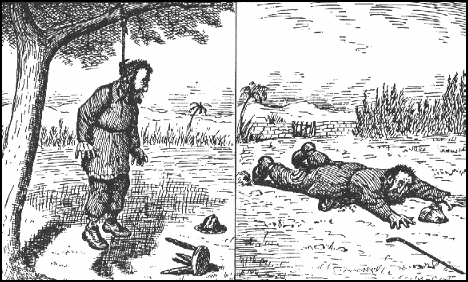Did Judas Iscariot die by hanging (Matthew 27:5) or did he perish by falling and bursting open (Acts 1:18)? Let’s see what the exegetical evidence will reveal.
The relevant passages here are:
Then he threw down the pieces of silver in the temple and departed, and went and hanged himself. = Matthew 27:5
Now this man purchased a field with the wages of iniquity; and falling headlong he burst open in the middle and all his entrails gushed out. – Acts 1:18

Some people have actually incorrectly assumed that Matthew and Luke (the author of Acts) are inconsistent in their account of Judas’ death. Given that the Bible is inerrant Judas can not have actually died by hanging and died by falling and bursting open. Rather they are 2 separate point of views of the very same event. For instance, if I saw a vehicle hit a pedestrian, I may just claim that the pedestrian passed away due to the fact that he was struck by the vehicle. The coroner who came on the scene later on however did not in fact see the accident may provide a graphic description of the injuries to the pedestrian. Both the coroner and I are identifying the very same event but merely separate aspects of it.
Matthew informs us that Judas died by hanging (death is presumed from the passage). Luke, being a physician, presents us a graphic description of what took place following the hanging. The justification for ordering the events as such is twofold. Firstly, if a person has actually fallen and their internal organs spilled out, they would die therefore could not subsequently die from hanging. Second, even when someone suffer bad falls, they do not typically burst open and have their internal organs spill out. Skin is remarkably tough, and even when it is cut in the stomach region, internals do not normally spill out. Therefore, it is not likely that Judas could possibly die in this way simply from falling.
Gruesome as it is, Judas’ dead body hung in the hot sun of Jerusalem, and the bacteria inside his body would have been actively breaking down tissues and cells. A by-product of bacterial metabolic process is typically gas. The pressure produced by the gas forces fluid out of the cells and tissues and into the body cavities. The body becomes bloated as a result. In addition, tissue decay takes place weakening the integrity of the skin. Judas’ body resembled an overinflated balloon: as he hit the ground (due to the branch he hung on or the rope itself breaking), the skin easily broke, and he burst open with his internal organs spilling out.
There is no contradiction surrounding Judas’ death however rather 2 descriptions provided by 2 different authors of the very same event.